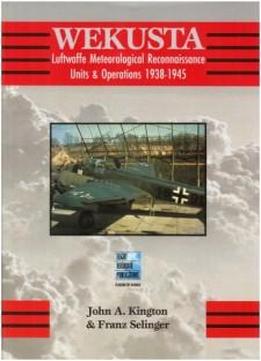
Wekusta: Luftwaffe Weather Reconnaissance Units In World War Two
by John Kington /
2006 / English / PDF
153 MB Download
This book lifts the curtain on a largely unknown or forgotten World
War II activity involving highly educated German atmospheric
scientists and pilots in the so-called Wetter-Erkundungs Staffeln
(Wekusta - Meteorological Reconnaissance Squadrons). The two
authors - one, Franz Selinger, a well-known German writer and
aerospace engineer, the other, John Kington, a highly competent
British writer and meteorologist - are uniquely qualified to
describe this important story as seen from both sides of the
warring countries. In doing so they make a remarkable contribution
to the history of aviation and meteorology, but also - and that is
perhaps their main concern - to the sacrifices and accomplishments
of the young scientists and pilots involved in these daring and
dangerous missions.
This book lifts the curtain on a largely unknown or forgotten World
War II activity involving highly educated German atmospheric
scientists and pilots in the so-called Wetter-Erkundungs Staffeln
(Wekusta - Meteorological Reconnaissance Squadrons). The two
authors - one, Franz Selinger, a well-known German writer and
aerospace engineer, the other, John Kington, a highly competent
British writer and meteorologist - are uniquely qualified to
describe this important story as seen from both sides of the
warring countries. In doing so they make a remarkable contribution
to the history of aviation and meteorology, but also - and that is
perhaps their main concern - to the sacrifices and accomplishments
of the young scientists and pilots involved in these daring and
dangerous missions.
At the height of the war the Wekustas included about a dozen
individual squadrons, totalling several hundred aircraft and over
1,000 flight crews. Encounters with enemy aircraft were frequent
and of an erratic nature, ranging from generous life-saving efforts
to attacks on downed crew members. After the secret 'Zenit' code of
the German aircraft reports was broken by British intelligence, the
RAF sometimes let German weather aircraft pass without attack
because their radio messages were considered more valuable than
shooting down the reporting aircraft.
At the height of the war the Wekustas included about a dozen
individual squadrons, totalling several hundred aircraft and over
1,000 flight crews. Encounters with enemy aircraft were frequent
and of an erratic nature, ranging from generous life-saving efforts
to attacks on downed crew members. After the secret 'Zenit' code of
the German aircraft reports was broken by British intelligence, the
RAF sometimes let German weather aircraft pass without attack
because their radio messages were considered more valuable than
shooting down the reporting aircraft.
The authors have gone to the admirable effort to list almost 1,000
names of flight crew members and their assignments. In this way
they honour their memory, their courage, and their contributions to
atmospheric sciences.
The authors have gone to the admirable effort to list almost 1,000
names of flight crew members and their assignments. In this way
they honour their memory, their courage, and their contributions to
atmospheric sciences.
The book fills a long-existing gap in the history of atmospheric
science and military aviation. Above all, it makes fascinating
reading.
The book fills a long-existing gap in the history of atmospheric
science and military aviation. Above all, it makes fascinating
reading.











